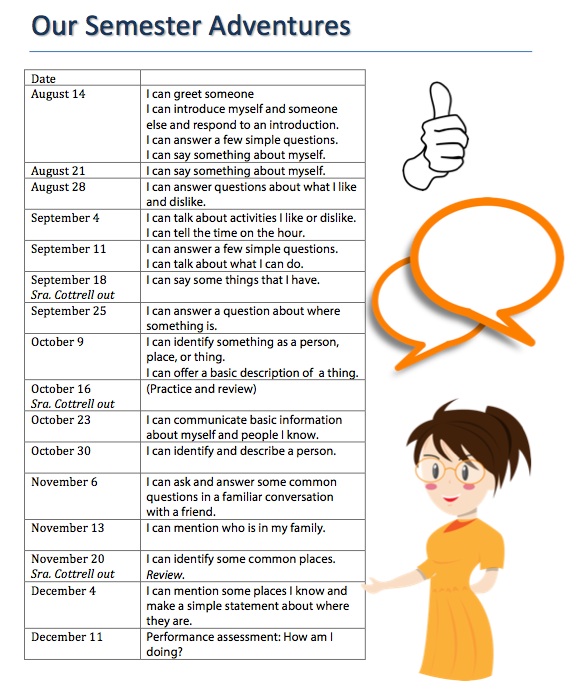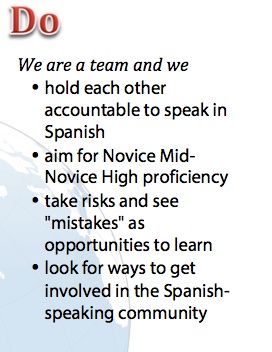Stressed about creating your class syllabi this year?
There are a lot of really great syllabi flying around the internet. There are even competitions to see who can do the (best? most creative?) one. I have to tell you, it’s stressful. I don’t at all think it’s intended this way, but I think it feels like really heavy peer pressure – including for those creating and posting their syllabi.
Whoa. Infographic syllabus, I didn’t know about those. I’ve got to do an infographic syllabus too! Otherwise, how will my students know how cool my class is going to be?
Oh my. Infographic isn’t enough. That interactive, infographic syllabus is amazing. If I’m going to be amazing, I have to do one too.
I am not mocking. I’m telling you honestly, these are the thoughts in my head, and so I’m guessing they’re in other teachers’ heads too.
I saw a few tweets last week that helped me realize I’m not alone in feeling this pressure (whew), and as I happened to be developing my syllabus for this year at the time, I decided to mull over what I thought were the essential items on my syllabi, and blog about it. And so, in order of importance:
5. Content overview
 I think this is the most-often-skipped element in a syllabus. Because of the syllabi I received in college (since I was homeschooled, that was my introduction to the concept), I assumed that a syllabus always gives students an overview of what the semester’s content entails. But when I got a teaching job I quickly found out that many teachers don’t include this, and the reason is usually that they haven’t mapped it out.
I think this is the most-often-skipped element in a syllabus. Because of the syllabi I received in college (since I was homeschooled, that was my introduction to the concept), I assumed that a syllabus always gives students an overview of what the semester’s content entails. But when I got a teaching job I quickly found out that many teachers don’t include this, and the reason is usually that they haven’t mapped it out.
If all you can get done before school starts is determine 1) what units/chapters you’re going to teach (you don’t have to teach them all!), 2) how long they will last (probably) and 3) where they fit in the calendar, you’ll feel more prepared for your school year and your students (and their parents) will greatly appreciate the bird’s-eye view.
4. Assessment policies
My students need to know this: how are they going to be assessed, and how often, and how will grades be calculated?
3. Tools
What tools will help students succeed in my class? I include both what resources will help them at home (Word Reference and Forvo are at the top of my list) and what they need every time they come into class.
 2. Classroom culture
2. Classroom culture
I believe that creating a target-language classroom culture centered in respect and mutual success begins on the syllabus. I outline brief guidelines for how we interact with each other and why.
And the top thing I must have in my syllabus:
1. Clarity
This is what keeps me from trying out some new ways to create syllabi. I know myself, and I don’t want to get so distracted by trying to be fancy that I muddy the waters. If my students start the year finding my syllabus confusing, will they be slow to believe they’ll comprehend what’s going on in class?
Please notice that I didn’t call this post the five things you must have in your syllabus. I do believe the one essential ingredient is clarity, but how that looks for you and your students, well, it could be a whole lot different than mine. So if you need permission to do a plain-Jane syllabus with clarity in your expectations and plans, here you go! I give you permission.
Have fun creating something that works for your classes!
Oh- and if you came to this post thinking I was going to post my syllabus, here’s the PDF, and here’s the .docx for you. The included images are royalty-free. Don’t feel like you need to use anything on mine, but I do want you to know that it includes (finally) a novice (no measurable proficiency) adaptation of the homework choice options.
12 Comments
Comments are closed.




I think you’ve captured the best parts of a solid syllabus (so of course I had to add it to my extravaganza post)! I mean, the Powers that Be are generally pretty insistent on the assessment part, but how often do we stop and lay out our expectations for class CULTURE explicitly? That’s essential, and yet I’m not even sure if I can communicate it to MYSELF clearly!
However, I want to point out that the infograph syllabus for me is not so much to communicate coolness as it is to make the essential information as accessible as possible, which comes back to clarity for me. Cutting back on verbage and using visuals is how that works in my little brain. Plus you know my Canva addiction–it’s something I just enjoy too! I guess it’s a way to share my hobbies with the kiddos.
Thanks for commenting, amiga. Believe me, we are all in awe of your mad syllabus skills! This all just moves so fast and I am so guilty of always comparing my practice to whatever my admirable colleagues are doing – my mind races with, “Should I confess I have never used Piktochart? That I’ve used Canva exactly ONCE? What amazing applications of Canva are my students missing because I won’t take the time to figure it out?? WHAT IF I’M BECOMING IRRELEVANT?!?!”
Summary: You are cool. AND you are effective. And I will try to calm down. 😉
Do you mind sharing yours? Thanks!
@Mafe – you can find Laura’s and several others in her post here. Enjoy!
I love this! I would love to think I could do this too!
Thank you for sharing your thoughts. You’ve read my mind (and that of many other teachers, I suspect). We are so intent on improving our practice that we unintentionally muddy the instructional waters by trying to do too much.
[…] expressed her self-doubts in this blog post in July. Or Sara-Elizabeth, with her recent post on the very quick evolution of syllabus practices. I feel weird when I’m linked to or quoted by other teachers with an awesome internet […]
Thank you, Sara-Elizabeth, for the positive, value-based syllabus. Creating the class culture from the first day with the syllabus sets the stage perfectly for my team-based classroom.
On your syllabus and choice lists you tell the student to “have one conversation with your amigo” on Fridays and on the choice to “ask your amigo to teach you a new conversation” – Is this “amigo” a classmate? older student? other?
Thanks so much for all that you do. I always learn when I read your posts!
Thanks for your question, Kristine! Always good to hear from you. The ‘amigo’ is a Spanish-speaker that the students find themselves to connect with to practice conversation. A native speaker is preferred but I challenge them to find someone with whom to speak Spanish. You can read more about the find-your-own-audience requirement in this post.
[…] time I knew the five ingredients I had to have in a syllabus, and you wanted to hear about them. This August post was the second most popular of the […]
[…] then Sara-Elizabeth Cottrell breaks down the absolute essentials of syllabusiness still further–infograph or no: content overview, assessment policies, tools, classroom […]